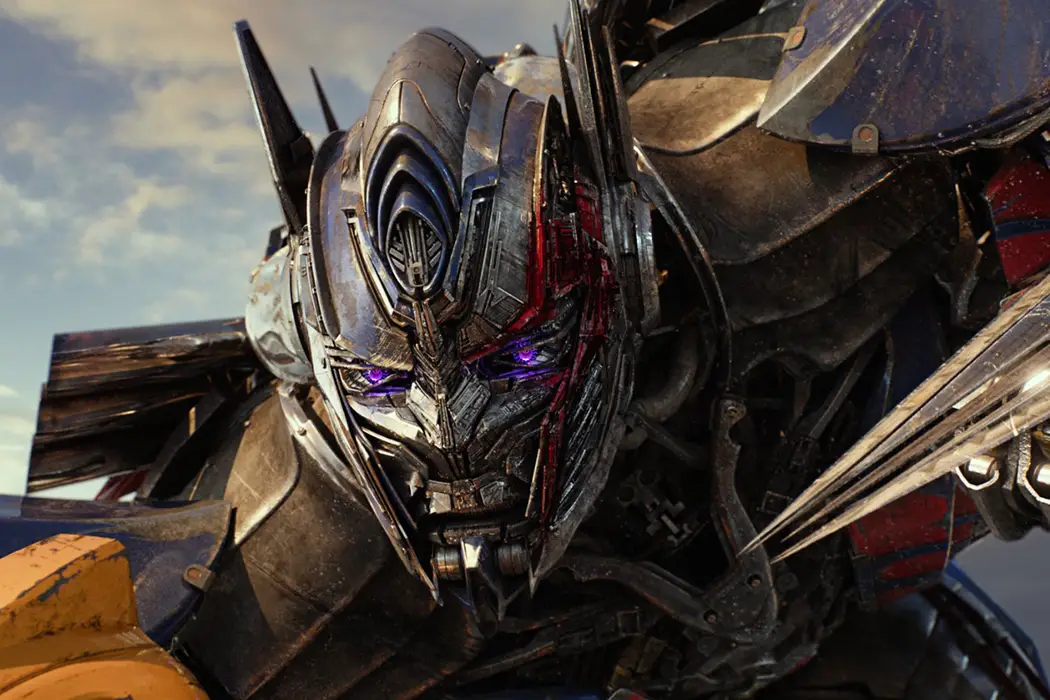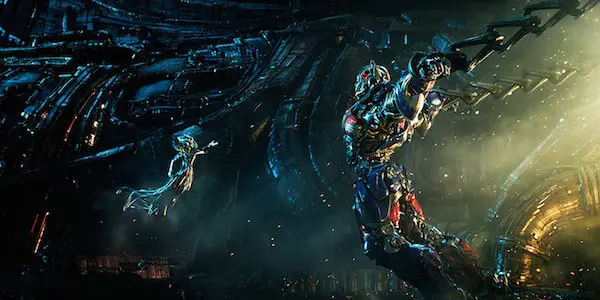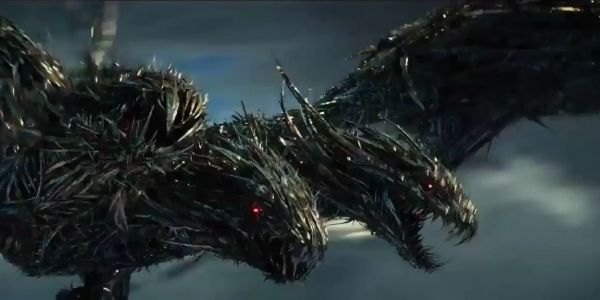TRANSFORMERS: THE LAST KNIGHT: Step 1 In The Franchise’s Transformation

Zachary is studying film at the University of Southern California,…
The latest and fifth entry in the live action Transformers film series is like the others, in that it is unmistakably Michael Bay. What sets Transformers: The Last Knight apart from its predecessors, first and foremost, is the film’s screenplay, credited to screenwriters Art Marcum & Matt Holloway (Iron Man) and Ken Nolan (Black Hawk Down), with a story credited to these writers and Academy Award Winner Akiva Goldsman (a personal hero of this budding screenwriter, the man who penned the screenplay for Ron Howard’s magnificent A Beautiful Mind).
The reason this film’s script is so different from the other entries in the series is because it is the first to come from the newly-anointed writer’s room, led by Goldsman, to break stories and assign scripts to writers for entries in the Transformers franchise. This is akin to TV writing, and aside from the Transformers films, the upcoming Guy Ritchie Sherlock Holmes third film has a writers room working on it, as well as the upcoming films in the MonsterVerse from Legendary Entertainment (next in the series are Godzilla sequel and Godzilla vs. Kong).
What is so different about the script is the breadth, scope, scale, and ambition of the film’s narrative. Enormous, expansive ground is covered, different time periods, different worlds, countless new Cybertronians and human characters, and some greatly appreciated nods to the films preceding this one. The writer’s room will next deliver a solo Bumblebee film, the casting for which is now underway (it will be led by Hailee Steinfeld).
The Last Knight
The Last Knight shows enormous potential with some of the new ground it breaks, whether it be its scenes with the Knights of the Round Table, or Bumblebee working with the Allied Forces to bring down the Third Reich in World War II, or the new characters of 15-year-old Izzy (Isabella Moner) and her Transformer companion Sqweeks trying to survive the constant danger they’re in.
There is also the TRF (the Transformers Reaction Force), working to annihilate any remaining Transformers on Earth. They break a deal with Megatron (Frank Welker) to save some human hostages, and this gets Megatron the location of the Autobots. The idea is they may destroy each other and solve the Transformer problem for humanity – though it doesn’t quite work out like that.
Then there is the film picking up where the previous entry, Age of Extinction left off, with Optimus Prime rocketing off into space, angrily looking for his creator. There’s also Mark Wahlberg’s Cade Yeager, finding himself targeted by the TRF, as he aligns himself with the Autobots. Picking up aspects from the earlier films, The Last Knight brings back some characters I’d hoped to see in the previous film, and while they were absent then, they are back now. John Turturro, Josh Duhamel and Glenn Morshower return to their roles, making this feel somewhat like the Transformers of old. Strangely absent is Duhamel’s military comrade, played by Tyrese Gibson. This film does, however, see the return of Stanley Tucci, who played in the previous film – that said, he has a different role here, and it’s a fun surprise.
Then there’s more new characters, Sir Anthony Hopkins’ zany chronicler of human and Cybertronian history, his robot butler Cogman (Jim Carter), Laura Haddock (Guardians of the Galaxy Vol. 2) as a university lecturer who has a central role in the story, Jerrod Carmichael in a comedic role, and Santiago Cabrera as a lead TRF fighter, who butts heads with Duhamel’s character, Lennox (Lennox is a covert US military embed in the TRF, advocating for not killing the Autobots on sight, while checking in with his superior, played by Morshower, back from the first three films).
We have yet to address the coming threat of the creator of the Transformers, the fact that she hijacks the mind of Optimus Prime (returning legend Peter Cullen), turning him into NEMESIS PRIME (can you not write that name in all caps? No, you cannot, it’s too good not to), and there’s the scientists and engineers of Earth trying to prep for and understand the threat posed by the Transformers’ creator, Quintessa (Gemma Chan), one of the ancient Cybertronian Primes. She claims to be the Prime of Life, of creation.

Needless to say, the film is DENSE. I can appreciate all the callbacks to the franchise’s past and the many new characters and worldbuilding, which could lead to exciting possibilities for future spinoffs – the film’s problem is its inability to fully execute all of these disparate elements in its 2 and a half hour runtime (which would be a near impossibility). Separate from the execution is how these elements all seem to lack integration with each other, and some characters disappear from the film, only to reappear later in (or not at all – like the inexplicably present mini Dinobots living at the junkyard with Autobots).
A separate issue with the script is the fact that it handles the robots more poorly than any of the other films; their dialogue here is the weakest it has been. Even lines uttered by Optimus Prime or Bumblebee’s radio talk just flat-out sound inauthentic compared to what we’ve heard from the Autobots in the past films. This is something that the previous screenwriters in the franchise, Roberto Orci, Alex Kurtzman, and Ehren Kruger, all had on lock.
Separate from the film’s weaknesses, a lot of the humor is solid, and the film overall works better than the previous two, Age of Extinction and franchise are the action and visuals, and they are very strong here. Bay exhibits his impressive eye for gorgeous shots and sequences, with some particularly inventive moments, such as one involving Bumblebee pretending to break into pieces, then wreaking havoc on his attackers by attacking while in pieces, and reassembling himself while still attacking – proving he’s a force to be reckoned with, and that he still has some tricks up his sleeve.
IMAX Confusion
A weakness with the film’s visuals has to do with its shooting format(s). Much to do has been made about how Bay used a new camera rig with two digital ALEXA IMAX cameras to get true digital IMAX 3D, and the entire film was shot using this format (allegedly). I see no way this can be true, as the film has at least three aspect ratios it distractingly cycles between, particularly during dialogue scenes. It’s as if Bay starts with a master shot or a single on the biggest star in the scene, shooting in IMAX, then it was too much work to move/reset the rig (which must be painfully heavy and cumbersome), so traditional digital cameras would be used to cover the rest of the scene (i.e., the less famous actors). Many of the shots of Wahlberg are full-frame IMAX, then the actor talking with him gets a standard scope shot.
With how much money and resources the production has, and the constant discussion of how the “entire” film was shot in IMAX 3D, this aspect of the film was maddening. Big action scenes tend to stay in the full digital IMAX aspect ratio of 1.90:1, but the variable aspect ratios are very annoying. Also, with one aspect ratio being scope and the other 1.90:1 for digital IMAX – what is the third aspect ratio? Christopher Nolan doesn’t mess with digital IMAX because it is pointless and he works in only two aspect ratios, scope (2.35:1) and true IMAX, (1.40:1 – a massively tall format). Bay used this setup for Dunkirk, in IMAX 70mm to experience what real IMAX is – it’s more than worth the higher ticket price, but not any other IMAX variant.
The WWII and Knight sequences are exhilarating, as are other action moments, but a major weakness of the film is its tendency to cut away from robot action, or visually obscure it by cutting around it, staging or shooting around it, or shrouding in smoke (transformations in particular). At this budgetary level, we should be able to soak in plentiful robot combat, and this time it either was left on the cutting room floor, or simply not created for the film. So often we get a Transformer takedown, but not the actual fight leading up to it, just the final shot or decisive blow.
Likewise, there are lengthy car chases involving normal cars, and not Transformers, which seems counter-intuitive. There are times when suspense is expertly built in anticipation of a showdown which never really comes, be that when the Decepticons come for Cade and the Autobots, or when we repeatedly see returning Decepticon Barricade (Jess Harnell), a favorite bot of mine. I kept anticipating him being able to do *something,* particularly have a rematch with Bumblebee, or fight… something… or someone. Barricade in this film belongs in the letdown category. This is not a problem with the first two films and the fourth, each with stronger action sequences that we are allowed to soak in as viewers.
There are several instances where the screenplay will introduce some aspect with enormous potential, be it the Izzy character, who has lost her family to Decepticon attacks, and is trying to stay alive, or Laura Haddock’s character who becomes central to the film’s underlying mission. There’s the internal conflict brewing with the TRF, or Hopkins and his role in the film, or the rampage of NEMESIS PRIME – all of these are exciting aspects, but none of them ever fully get to take off. This is in combination with the oft-lacking robot fight sequences, and the film’s biggest weakness, its third act (loud, unfocused, and unable to deliver a satisfying resolution to aspects which were much more exciting upon their introduction in the film). All this works to illustrate that the film is indicative of an attempt to move into new territory with the franchise – but it’s barely the first step. All these aspects lack the necessary execution to deliver beyond the enticing possibilities for storytelling that they represent.

The third act issues result largely from it being the hardest part of the film to follow. It is convoluted, long (albeit with a far too abrupt wrap-up), and disappoints with its action. It overwhelms, and not in a good way. The potential the film exhibits, which I keep referencing, abounds in the first act, and in ways in the second act. The film suffers, as it can’t integrate these story aspects that alone are enticing, likewise moments and turns that should be big just don’t deliver, and a lot of these downfalls could have been fixed with simple touches in post.
This being the first film from the writer’s room means that the coming installments may be able to capitalize on some of the potential and groundwork established here – likewise, the franchise expanding outwards to new story realms means the films will get to break more ground. I personally am excited to see where the films go, and despite my issues with The Last Knight, I was pleasantly surprised with aspects of its human story, Haddock, Hopkins and Moner’s characters in particular. I even enjoyed Wahlberg in this film, which came as an enormous surprise, as I couldn’t stand his character in the previous film.
Music That Amps Up The Experience
Another aspect which worked to maximize my enjoyment of the film is its score, from series stalwart, composer Steve Jablonsky. Each film in the series has its own musical identity while retaining a common overarching sound. As a film score enthusiast, few things make me happier in ongoing franchises when the composer is retained from film to film; this is because the composer gets to re-incorporate themes he or she has written for previous entries in the franchise. Since Jablonsky has composed all five films in the series, he’s able to reuse his material, which invokes enormous nostalgia for longtime fans of the series, like myself. Likewise, it rewards attentive listeners who can recall bits of the previous films’ scores.

In The Last Knight, Jablonsky reuses some themes from previous films in the form of both near direct re-recordings, or re-orchestrations, presenting old themes in a new way – either method works enormously well and some of the music calls back to ten years prior, when the first film made its theatrical debut, in 2007. In terms of new material for The Last Knight, Jablonsky colors the score with sweeping, operatic orchestrations to accompany the dips the film takes into Arthurian legend.
This doesn’t stop Jablonsky from incorporating synth-heavy moments for the modern-day stretches, and one piece in particular is notable for its seemingly contradictory nature to what is onscreen. During the third act, as the humans and Autobots are charging into enemy territory, the outcome looks bleak and desolate, and the military officers order the mission to be aborted. The group charges on anyway, into danger, and the score counters this with a light, hopeful piece. Seeing The Last Knight again, this continued to strike me as a unique choice from Jablonsky. There’s also two hilarious moments where the score breaks into the diegesis, something I’m sure he had fun with. It’s been enjoyable to re-listen to the score, and when revisiting The Last Knight, it will be one of the aspects I will most look forward to.
The Last Chapter Of The Review For The Film Falsely Called The Last Chapter…
The Last Knight fails to reach the height of the series’ first two films, this due in part to how much this film tries to accomplish, while the first two were more simple in narrative and easier to follow. Even as a hardcore fan of the franchise and its larger mythology, I found myself struggling with which Transformer is which, and how aspects of the larger story worked together.
Despite the numerous issues I delineate above, The Last Knight objectively is more entertaining than the third and fourth films, Dark of the Moon and Age of Extinction. I was pleasantly surprised by how much I cared about the human story, particularly of Laura Haddock’s character, and it was my involvement in the story that allows me to excuse some of the film’s action shortcomings. It is a shame that a Transformers film is lacking sufficient fight sequences, but as the work overall entertained me, I can deal with it.
The alternative is the previous film, Age of Extinction, having better action sequences, but a story/characters I mostly cared nothing for (with some exceptions), and it was a film that felt so separate from the franchise. This one reintegrating familiar faces and picking up aspects of the first three films in addition to aspects from the fourth film made it work better for me than the fourth. Likewise, it uses aspects introduced in the fourth film better than the the fourth film itself (such as Wahlberg’s character).
The stronger story here paired with the better comedic relief elevated The Last Knight from the last two entries, giving it merit in areas I didn’t expect. This is something most critics who reviewed the film wouldn’t dare discuss, as it is in vogue to outright dismiss this franchise whatsoever. I had fun with this film, and will acknowledge and agree with many of the issues it has (a Decepticon character introduction sequence in act two, right out of Suicide Squad, is horrendous, for example). That said, I don’t let the problems alone define my experience with The Last Knight, as I still had fun with it, and enjoyed the nods to the films of the past (eagle eyed viewers will spot references to Dark of the Moon, Revenge of the Fallen, and certain familiar faces and locations from the past films). When it comes to Transformers: The Last Knight, dare I use the phrase, there is “more than meets the eye.”
Which Transformers film is your favorite?
Transformers: The Last Knight is now playing worldwide.
Does content like this matter to you?
Become a Member and support film journalism. Unlock access to all of Film Inquiry`s great articles. Join a community of like-minded readers who are passionate about cinema - get access to our private members Network, give back to independent filmmakers, and more.
Zachary is studying film at the University of Southern California, in Los Angeles. He is enamored with blockbuster films (both the hits and the flops) and the tech, toys and tools that go into making them. He aspires to bring an indie sensibility to big films in his career as a writer/director/actor, and looks to writer/director/actors like Jon Favreau and Ben Affleck for inspiration. He is notorious for appreciating films that the masses seem to loathe, and loves film scores and composers. While he loves the big movies, he also loves a good indie (and shouting to the heavens above about said indie). He may or may not have a penchant for collecting Blu-rays, and when not writing/making/talking/reading/listening to film-related material, he likes to do other stuff... like watch TV (and perhaps other things as well).













